Western Digital Caviar Green 3TB and My Book Essential 3TB Drives Reviewed
by Anand Lal Shimpi on October 19, 2010 1:43 PM EST- Posted in
- Storage
- HDDs
- Western Digital
- 3TB
Let’s Go Outside: My Book Essential
Western Digital also sent along the My Book Essential, an external version of the 3TB Caviar Green. Unlike Seagate’s GoFlex Desk, the My Book Essential doesn’t have an option for interfaces: USB 3.0 is all you get. Obviously USB 3.0 is backwards compatible with USB 2.0 on the host connector side.
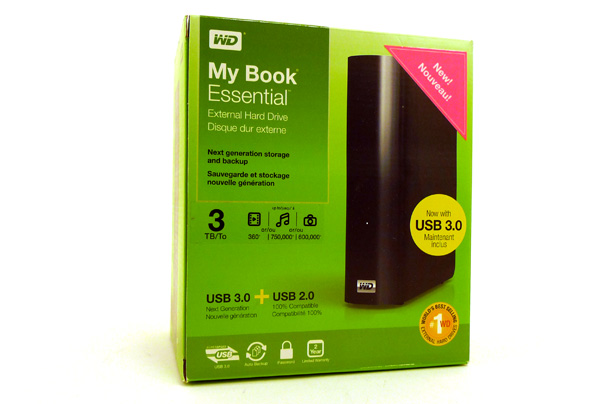
The first thing I wanted to test with the My Book Essential was how well it kept the drive cool. Remember the Caviar Green is a 4 platter sub-6000 RPM drive compared to the 5-platter 7200 RPM design in the GoFlex Desk, so temperatures should inherently be lower. To make sure the drive never gets too hot Western Digital has a grate that runs along the top, spine and bottom of the My Book Essential. A pair of rubber feet prop the drive up a few millimeters off of the ground to allow air in from below.The ventilation story is a lot better than what I encountered with the GoFlex Desk.


As a result, temperature is a non-issue. Here’s the drive at idle and after over an hour of use:
| Thermal/Power Comparison | |||||
| Idle | Load | Power Consumption (Idle/Load) | |||
| Western Digital My Book Essential 3TB | 34C | 49C | 5.30W / 9.60W | ||
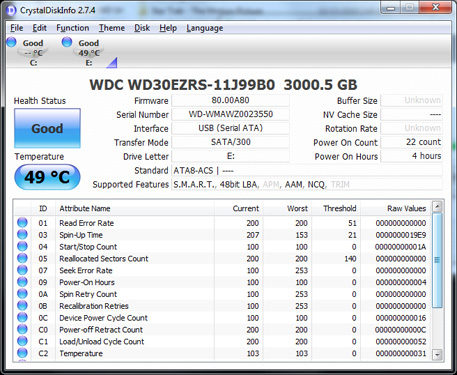
Like Seagate, Western Digital supplies software with the drive to manage the drive and backups. Western Digital doesn’t bundle a NTFS Mac driver so you’ll need to reformat the NTFS formatted drive for write use on a Mac (or supply your own NTFS driver for OS X).
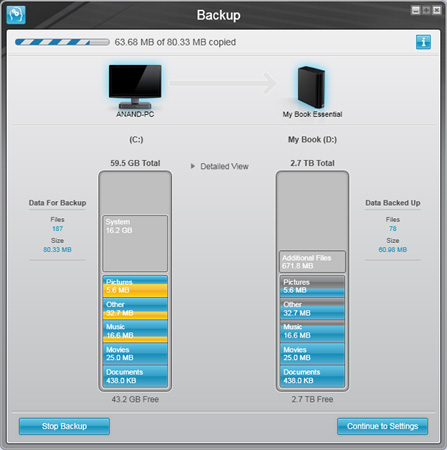
WD’s SmartWare utility does let you seamlessly lock and unlock the drive across both Windows and OS X however.

The performance of the My Book Essential isn’t nearly as good as what we saw with the GoFlex Desk. Seagate is over 25% faster for sequential reads and writes over USB 3.0. I’d say the tradeoff is worth it given the tremendous difference in heat however.
| External 3TB Performance Comparison | |||||
| Seagate GoFlex Desk 3TB (USB 3.0) | Western Digital My Book Essential 3TB (USB 3.0) | Western Digital My Book Essential 3TB (USB 2.0) | |||
| Sequential Read | 151.9 MB/s | 120.6 MB/s | 37.8 MB/s | ||
| Sequential Write | 151.2 MB/s | 119.7 MB/s | 32.9 MB/s | ||
| Random Read | 0.30 MB/s | 0.18 MB/s | 0.17 MB/s | ||
| Random Write | 0.93 MB/s | 0.84 MB/s | 0.82 MB/s | ||
USB 3.0 continues to be a great interface for external storage. There’s very little sequential performance difference between the 3TB My Book Essential and the desktop Caviar Green. Random performance is significantly lower, presumably because of the translation that happens at the USB controller level. As an external drive, you’re more likely to be writing to the My Book Essential sequentially rather than throwing a more random workload at it.
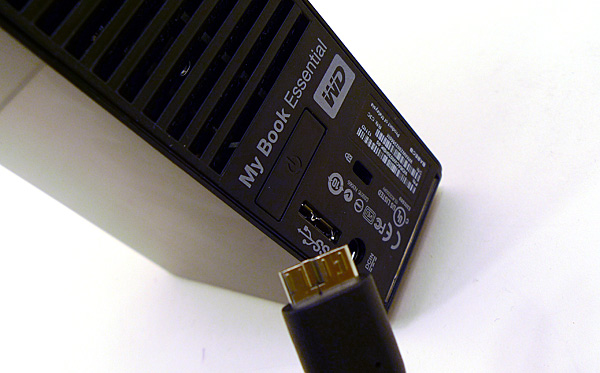

The only problem I had in testing the My Book Essential was very erratic read performance at the beginning of my testing. Here’s a shot of the first sequential read pass on the drive:
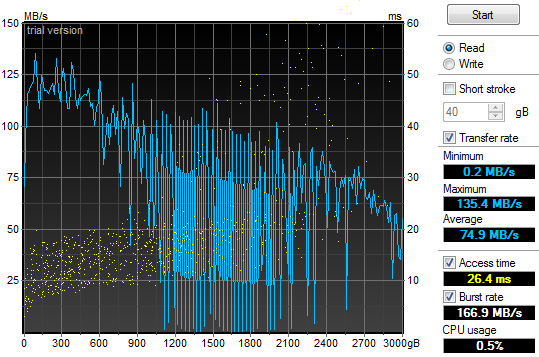
The problem mostly resolved itself after further passes, although there were always some strange performance blips aross various LBAs:

Write performance is also impacted:
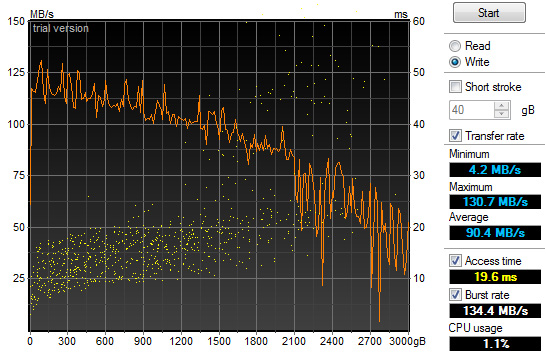
You'll notice that I didn't see these problems with the internal drive, which leads me to believe that this is either a problem with my review sample or with the USB 3 to SATA bridge in the My Book Essential itself. The variable performance also isn't consistent between runs or benchmarks
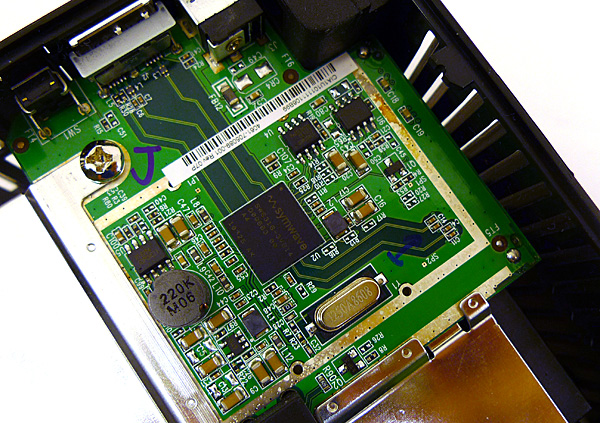
The move to USB 3 adds about a 3+ ms latency penalty compared to the internal drive. This is ok for backups and large file storage, but it's not something you'd want to use as an application drive.










48 Comments
View All Comments
krumme - Tuesday, October 19, 2010 - link
Can we perhaps see this in a My Book World Edition?Thanx for the fine HD reviews Anand
ervinshiznit - Tuesday, October 19, 2010 - link
So with the 32 bit LBA restriction, does this mean that its possible to boot from a partition on a 3TB drive as long as that partition is no larger than 2.1TB?davepermen - Tuesday, October 19, 2010 - link
And it's especially nice that the old small 2TB drives are now really cheap. Put a new one to celebrate into my windows home server. The 3TB ones won't be supported for whs1 anyways, so it's cheap 2TB drives from now on.Then, when the 3TB will be in the same price/gb ratio, the next disk will be needed, and whs2 will be there, supporting them.
And yes, storage (in my case, networked storage thanks to whs) + ssd in the systems is definitely the best setup. 100% agreed.
ratbert1 - Tuesday, October 19, 2010 - link
"The controller supports booting to a 3TB formatted drive if your motherboard has EFI support."The chart shows support for boot with 64 bit Vista and 7 with the HBA controller. If you have 32 bit, you can use it as a data drive.
SteelCity1981 - Tuesday, October 19, 2010 - link
It's totally pointless to make 6gb platter hard drives. At least WD understands that.Taft12 - Tuesday, October 19, 2010 - link
Nobody makes 6GB/platter drives... at least not since 1999!SteelCity1981 - Wednesday, October 20, 2010 - link
I'm talking speed not size duh.Roland00Address - Tuesday, October 19, 2010 - link
Western Digital Caviar Black WD6402AAEX 640GB 7200 RPM SATA 6.0Gb/s 3.5"Western Digital Caviar Black WD1002FAEX 1TB 7200 RPM SATA 6.0Gb/s 3.5"
Western Digital VelociRaptor WD4500HLHX 450GB 10000 RPM SATA 6.0Gb/s 3.5"
Western Digital VelociRaptor WD6000HLHX 600GB 10000 RPM SATA 6.0Gb/s 3.5"
bennyg - Saturday, October 23, 2010 - link
If you were uninformed, you would think a SATA 6GBPS 3TB HDD is faster than a SATA 3GBPS 3TB HDD. So marketing people think it's very useful.ytoledano1 - Tuesday, October 19, 2010 - link
In most cases, data is lost due to user error, virus, theft or fire - RAID1 protects against none of these. RAID1 will protect you against disk failure, but its main advantage is in mission-critical servers where you don't want to reboot the machine when replacing a drive. How many desktop users need this feature?Worst, people might think that their data is backed up 'cause their disk is redundant. It's not.